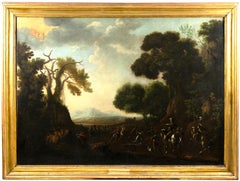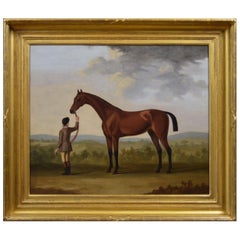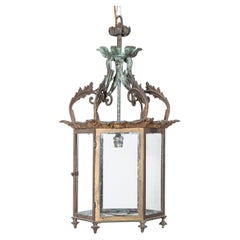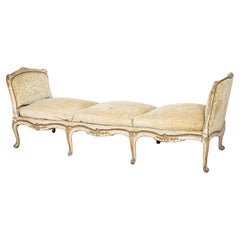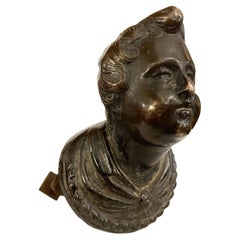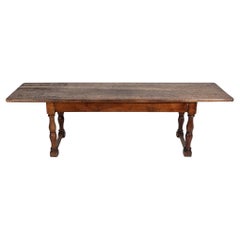Europe
to
8,037
28,314
17,848
344,850
250,504
157,890
141,009
103,854
77,207
50,741
50,113
44,006
35,272
28,314
27,355
22,598
20,013
15,984
15,570
14,747
14,180
11,697
10,739
10,463
7,580
5,841
5,748
4,977
4,411
4,314
3,593
2,817
2,609
2,118
2,112
1,940
1,552
1,469
1,277
1,188
1,135
1,005
954
932
857
715
683
523
500
392
302
281
228
221
197
195
168
165
154
115
109
99
60
45
39
100
95
92
85
73
Period: 18th Century and Earlier
Period: 1650s
Martyrdom of Saint Stephen- Painting attr. to Vincent Adriaenssen- 17th Century
Located in Roma, IT
Landscape with martyrdom of Saint Stephen is an old master artwork realized in 17th century.
Mixed colored oil painting on canvas.
Includes coeval gilded frame cm. 148x196.
The artwork is attributed to Vincent Adriaenssen called il Manciola (Antwerp, 1595 - Roma, 1675)
Among the painters who worked in the first half of the seventeenth century it is possible to indicate only the Neapolitan Scipione Compagno (1624-1680) as the author of scenes of martyrs set within a landscape or a view such as, for example, the Martyrdom of Saint Stefano recently hesitated at the Ansorena in Madrid on June 16, 2021. It should be noted, however, that the landscape represented in the painting examined here, characterized by luxuriant vegetation, meticulously represented "in the Flemish style", shows differences with the typical settings of the paintings di Compagno, characterized above all by urban views, visionary architectures or rather arid vegetation. Even the refined figures, so elongated and lanky, represented in our painting, in particular the group of knights in the foreground on the right, are not reflected in the production of the Neapolitan painter. These elements, to which we add the depiction of the Eternal Father amidst the clouds and the detail of the dog in profile in the foreground, instead recall a painter mainly known as a battle soldier, but who was also the author of many works depicting episodes from ancient Rome set within luxuriant landscapes, or rather Vincent Adriaenssen known as Manciola, a painter from Antwerp whose figure has been shed light thanks to recent studies. The group of horsemen represented to the right of the examined painting is, in fact, comparable with other groups on horseback present in numerous works by Manciola such as, for example, in the Triumph of Caesar (Rome, Babuino, 23-03-2010; formerly Florence, Collection Privata, 2006), while similar elongated and somewhat lanky figures, dressed in red, yellow, blue and white, can be found in the three paintings conserved at the Cassa di Risparmio di Pesaro, which in the past were erroneously attributed to the Umbrian painter Francesco Allegrini...
Category
17th Century Old Masters Europe
Materials
Oil
18th Century sporting horse portrait oil painting of a race horse and groom
By Francis Sartorius
Located in Nr Broadway, Worcestershire
Francis Sartorius
British, (1734-1804)
Bay Hunter & Groom
Oil on canvas, signed
Image size: 24.25 inches x 29.25 inches
Size including frame: 32 inches x 37 inches
A wonderful spor...
Category
18th Century Old Masters Europe
Materials
Canvas, Oil
English Georgian Hexagonal Glazed Verdigris Lantern
Located in Staffordshire, GB
Circa 1800
English Georgian Hexagonal Glazed Brass/Bronze Verdigris Lantern
Exceptional quality, rewired with original chain & hanging hook
Measures: W33 x D33 x H57 cm.
Category
1790s British Antique Europe
Materials
Brass, Bronze
Italian Louis XV Recamier, 18th Century
Located in Greding, DE
Large Louis Quinze chaise longue with curved legs and intricately carved floral decorations on the apron. The upholstered and rounded side panels add an elegant and inviting touch to...
Category
18th Century Italian Louis XV Antique Europe
Materials
Fabric, Wood
Figurative Knob in Bronze 1600 Italian Handle with Bust of Boy
Located in Milano, MI
Bronze Bust Of 1600s, cast depicting a young boy with curly hair and a gathered robe over his neck ending in an oval section with beaded border. This antique bronze knob of Italian ...
Category
17th Century Italian Baroque Antique Europe
Materials
Bronze
18thC Large French Walnut Drapers Table
Located in Staffordshire, GB
Circa 1790.
18thC large French walnut drapers table
Sourced from the South of France
(lower stretchers removed in the past)
W 270 x D ...
Category
Late 18th Century French Antique Europe
Materials
Walnut
Antique Oak Chest of Drawers
Located in Oxfordshire, GB
Jacobean Style Chest Of Drawers.
A Jacobean style oak chest of drawers raised on four large bun feet. The graduating cushion moulding drawers are full length and with brass drop hand...
Category
Late 18th Century British Antique Europe
Materials
Oak
Large 18th century French walnut reclining armchair
Located in Malton, GB
These are always great characterful chairs that get people talking. This is a beautifully original 18th century French example with a stunning walnut frame and patinated ironwork. Th...
Category
18th Century Antique Europe
Materials
Walnut
Old Map of the Mughal Empire, Persia in the West to Lake Chimay etc., ca.1685
Located in Langweer, NL
Antique map titled 'L'Empire du Grand Mogol'. Old map of India and Central Asia.
The map extends from Persia in the West to Lake Chimay and the Bay of Bengal...
Category
1680s Antique Europe
Materials
Paper
Exceptional Pair of 18th Century Swedish Gustavian Gilt Wood Mirrors
Located in Allerum, SE
Exceptional, rare and unusually large pair of late Gustavian gilt wood mirrors with gouaches in neoclassical Pompeian style and faux porphyry marble mirror frame. Stockholm, ca 1790.
Category
Late 18th Century Swedish Gustavian Antique Europe
Materials
Mirror, Wood, Giltwood
18th Century Spanish, Hand-Painted Glazed Ceramic Plate from Triana
Located in Marbella, ES
18th Century Spanish hand-painted glazed ceramic plate from Triana.
Category
18th Century Spanish Antique Europe
Materials
Ceramic
18th Century Silk Brocade Altar Frontals PAIR
By Aubusson Manufacture
Located in Canterbury, GB
A pair of antique Altar Frontals
Dating from 18th Century
Gold silk ground brocaded with a Crown above Eight Point Stars , Cross, and stylized Pomegranates
Lined in crimson silk
...
Category
Mid-18th Century Spanish Baroque Antique Europe
Materials
Silk
Historical Portraits of Six Incan Rulers, Peru, 1752: A Copperplate Collection
Located in Langweer, NL
A copperplate print from 1752, showcasing portraits of six Incan rulers from different periods. Each ruler is depicted within a circular frame, symbolizing their historical and cultu...
Category
1750s Antique Europe
Materials
Paper
Antique 18th Century Iberian Emerald Chandelier Earrings
Located in Idar-Oberstein, DE
Antique Iberian Emerald Earrings, ca. 18th Century
A rare pair of antique Iberian - Portuguese earrings in yellow gold and silver, studded wi...
Category
18th Century Spanish Georgian Antique Europe
Materials
Emerald, Gold, Silver
18th-Century Engraving of European Monarchies with Heraldry and Imperial Regalia
Located in Langweer, NL
Title: 18th-Century Engraving of European Monarchies with Heraldry and Imperial Regalia
This intricately detailed 18th-century engraving, *Statua Regum et Ropotorum P.C.N.*, offer...
Category
1740s Antique Europe
Materials
Paper
Abraham Brueghel (1631-1690) Attribution - "Triumph of Flowers and Fruits" 17th
By Abraham Brueghel
Located in Madrid, ES
Abraham Brueghel (1631 - 1690) Attribution - "Triumph of Flowers and Fruits in Plein Air"
oil on canvas
95 x 130 cm without frame
100cm x 135cm with frame
good conditions
Abraham Br...
Category
17th Century Dutch Baroque Antique Europe
Materials
Paint
Antique George III Quality Mahogany Dining/Centre Table
Located in Suffolk, GB
Antique George III quality mahogany dining/centre table having a quality mahogany top with two drop leaves, swing out gateleg action for support standing on turned tapering legs with...
Category
18th Century English George III Antique Europe
Materials
Other
Caravaggesque Oil on Copper "Flagellation of Christ" Baroque Sicilian, 17th Cent
By (After) Caravaggio
Located in Milano, IT
Splendid 17th-century Italian painting by unknown artist, but certainly a follower of Caravaggio, relying on style and drawing.
The painting has a very beautiful gilded wooden frame, with a subtle greek with spheres and an overlying rectangular frame with sinuous flowers on each corner, very elegant and beautiful.
The painting depicts one of the most depicted religious scenes ever, the scourging of Christ, and is entirely done in oil on copper.
The scourging of Jesus is an episode narrated in the Gospels (Mk15:15-16; Mt27:26-27; Lk23:16-26; Jn19:1-17[1]).
Scourging is a flogging, particularly bloody, by means of sticks, rods or cat-o-nine-tails, the latter instrument consisting, in the Roman typology, of a short stick to which were secured several strings ending in metal claws, leads and bone splinters that caused tremendous lacerations and fractures to the tortured person. Chains are used in this scene, both to immobilize Jesus Christ and to flog him, as we can see in the upper right hand of the scourger.
According to some personal research, it turned out that the actual scourging of Christ was mostly depicted at the column, while this Christ is on the ground, so presumably Christ here is scourged during the Way of the Cross at one of those stages where he fell.
The painting has a very dark coloring, which is why this painting is believed to faithfully follow Caravaggio's style of dry, authoritarian brushstrokes. The painting shows a figure agonizing on the ground that continues to receive beatings and floggings of all kinds, representing Christ; his face is crucified in a loquacious expression of pain, he turns his eyes to heaven as if to invoke God, but at the same time those same eyes admonish the wickedness and arrogance inherent in humanity.
Christ has one hand resting on the ground in the act of holding himself, while the other takes a completely unnatural stance against the barren ground. His body appears hardened to wanting to parry the blows, his legs are curled up on his knees as he takes kicks from the soldier above him. Christ is depicted pinned down from the neck with a very large and strong black iron bolt held by the other soldier. The soldier on the right in the foreground wears a one-shoulder tunic with an orange tunic and blue pants. On his feet he wears gray shoes, at his waist he has a belt with an iron helmet...
Category
17th Century Italian Baroque Antique Europe
Materials
Copper
A George II Carved Pine and Limewood Chimneypiece
Located in London, GB
Predominantly uncarved, this stripped pine and gesso chimneypiece is of neoclassical form and austere complexion. A waterleaf moulding in gesso frames the aperture and the central ta...
Category
Mid-18th Century English George II Antique Europe
Materials
Wood, Pine
Jacob weeps over Joseph's tunic, Antique Flemish Tapestry Circa 1600 - N° 1498
Located in Paris, FR
This tapestry has already been cleaned in our craft workshop
The setting sun bathed the hills of Canaan in golden light, but in Jacob’s heart, darkness reigned. He sat bent, his eye...
Category
17th Century French French Provincial Antique Europe
Materials
Wool, Silk
18th Century Italian Wood and Gesso Altar Vase in Rose Silver
Located in Hastings, GB
A hand-crafted wood and applied gesso altar vase, late 18th century with gilt rose silver finish.
Small areas of loss to the gesso and wear to the paint commensurate with the age of...
Category
Late 18th Century Italian Baroque Antique Europe
Materials
Gesso, Wood
Roman Marble Trapezophorus circa 1st-2nd Century A.D
Located in Madrid, ES
A Roman marble trapezophorus in the Form of a Barbarian Dacian young figure.
Circa 1st-2nd century A.D.
Measure: height 24 1/4 inches (62 cm).
Property from Mr. Radu Moldovan, Skokie, Illinois
Provenance:
B.C. Holland Gallery...
Category
15th Century and Earlier Italian Classical Roman Antique Europe
Materials
Marble
Magnificent Antique George II Brass Face Red Walnut Longcase Clock
Located in Suffolk, GB
This is a magnificent example of a George II brass face red walnut longcase clock. The hood having and elegant broken swan-neck pediment and bras...
Category
Mid-18th Century English George II Antique Europe
Materials
Brass
Large Amethyst Chapel
Located in London, GB
This large amethyst chapel, a complete half of the original geode, shows
deep purple amethyst crystals punctuated with small stalactites and overlaid
...
Category
15th Century and Earlier Uruguayan Antique Europe
Materials
Agate, Amethyst, Quartz
17th century Antique Aubusson/Gobelin tapestry, France Architectural land, silk
Located in Berlin, DE
17th century Antique Aubusson/Gobelin tapestry, France Architectural landscape, silk
Antique Museal Aubosson tapestry made of silk and partly wool. Very fine and antique design. Dep...
Category
17th Century French Baroque Antique Europe
Materials
Wool, Silk
Dutch Delft blue tiles serving tray, 1650-1700
Located in Delft, NL
Dutch Delft blue tiles serving tray, 1650-1700
A serving tray in oak wood with Dutch Delft blue tiles, 1650-1700. The tiles with scene of animal in blue lined circle. The most unusu...
Category
17th Century Dutch Antique Europe
Materials
Earthenware
Venetian-Cretan master early 16th century Tempera on Gold Background
Located in Pistoia, IT
Venetian-Cretan master of the early 16th century, icon of Christ the Bridegroom (or Nymphios).
Tempera on gold ground on panel.
Measure 41 x 29 cm
Holy Week, in Eastern tradition an...
Category
16th Century Renaissance Europe
Materials
Tempera, Board
Rare Antique Judaica Bronze Oil Lamp with Hebrew Inscriptions
Located in Doha, QA
An extraordinary very rare Holy Sabbat oil lamp with the Hebrew language inscriptions which means “Holy Sabbat”. Made out of bronze and has an untouched patina. Those kind of Oil Lam...
Category
15th Century and Earlier German Antique Europe
Materials
Bronze
Chest of Drawers Black Baroque Period Sweden
Located in New York, NY
Chest of Drawers Black Baroque Period Sweden. A chest of drawers made during the baroque period 1650-1750
Made in oak repainted in Laserow Black. Later hardware.
Category
Late 17th Century Swedish Baroque Antique Europe
Materials
Wood
18th Century Italian Baroque Hand-carved Limestone Holy Water Font or Stoup
Located in Buisson, FR
Beautiful Baroque hand carved limestone holy water font or stoup,
Unique and original period piece. Italy, circa 1750. Good but weathered condition just as it should.
Measures: H:10c...
Category
18th Century Italian Baroque Antique Europe
Materials
Limestone
Antique English Inlaid Mahogany Tea Caddy, circa 1790
Located in Bath, GB
A very handsome George III tea caddy, made from Mahogany and beautifully inlaid with panels and highly decorative foliate marquetry to the front and top. The top has a handsome cast ...
Category
1790s English George III Antique Europe
Materials
Mahogany
Large Italian Bureau 18th Century Inlayed Walnut Chest of Drawers with Flap
Located in Milano, MI
An Italian monumental sized bureau with flap dating back to the second half of 18th century. Three deep drawers and a fall-front opening to reveal a fitted interior with six small dr...
Category
1770s Italian Directoire Antique Europe
Materials
Cherry, Maple, Walnut
18th Century Spanish Valencian Manises Lusterware Ceramic Plate
Located in Marbella, ES
Glazed ceramics with lustre-painted decoration
This is glazed ware, i.e. it is glazed with a white enamel bath, very pure in the best examples, which is f...
Category
18th Century Spanish Antique Europe
Materials
Ceramic
Byzantine Gold Coin Pendant: Christ; Michael, Constantius, Andronicus on rear
Located in Roma, IT
An authentic Byzantine gold coin—Histamenon (1068-1071 AD)—is set in this beautiful 18kt Gold pendant. On the front, Christ crowns Emperor Romanus ...
Category
15th Century and Earlier Italian Classical Roman Antique Europe
Materials
18k Gold
Portrait of a French lady by Robert Le Vrac Tournieres, circa 1725
Located in PARIS, FR
Portrait of a young Lady
Robert Le Vrac Tournières (1667-1752)
18th century French school, circa 1725
Oil on canvas
Dimensions: h. 81 cm, w. 65 cm
Important 18th century Régence per...
Category
Early 18th Century Old Masters Europe
Materials
Canvas, Oil
Superb 17th Century Spanish Vergueno On Stand
Located in Lincolnshire, GB
A fine example of a late 17th century Spanish vargueno on stand. The early mahogany cabinet has the original iron mounts and the fall front opens to reveal a beautifully fitted inter...
Category
Late 17th Century Spanish Antique Europe
Materials
Iron
Italian 18th Century Rococo Carved Walnut Sofa or Canape
Located in Berlin, DE
Italian 18th century rococo carved walnut sofa or canape
Standing on four cabriole legs with stylized foliage a carved rocaille shaped apron with a padded seat. The padded back with a carved wooden frame decorated with acanthus leaf scrolls and a cresting centered by a large rocaille.
The carving presents elegance and movement in a vivid manner with powerful rocaille carving as is characteristic of Italian Rococo furniture...
Category
1760s Italian Rococo Antique Europe
Materials
Walnut
A Large Louis XVI Breche Marble Fireplace Mantel
Located in London, GB
A large and highly variegated Breche de Saint Maximin marble fireplace from the very late 18th century. Rich in colours of purple, creams, white, gold and deep reds. The console jamb...
Category
Late 18th Century French Louis XVI Antique Europe
Materials
Marble
Spectacular Citrine: Polished Perfection from Brazil
Located in London, GB
Feast your eyes on this breathtaking polished citrine from Brazil, a true marvel of natural artistry. This stunning specimen boasts remarkable transparency, allowing the rich brownis...
Category
15th Century and Earlier Brazilian Antique Europe
Materials
Crystal, Quartz
Salamander-shaped pinjante.
Located in MADRID, ES
Its devotional pinjante votive offering which origin is Spanish, of Canarian manufacture.
The piece represents a salamander crafted in solid gold, richly adorned with emeralds, rub...
Category
16th Century Spanish Renaissance Antique Europe
Materials
Emerald, Freshwater Pearl, Ruby, 22k Gold
17th Century Italian Commode with Secretaire
Located in Vo', Veneto
"Canterano" chest of drawers with flap/desk
Measurements: H. 102 cm - W. 142 cm - D. 62 cm
Period: 1600
Origin: Emilia - Italy
Wood: Walnut, Poplar
Description:
Beautiful "Canteran...
Category
1650s European Baroque Antique Europe
Materials
Nutwood
Iroquois Warrior: 1783 Engraving by Teodoro Viero of a Native of Northern Canada
Located in Langweer, NL
An original engraving titled "Iroquois Warrior," created by Teodoro Viero in 1783. The artwork is a detailed depiction of a member of the Iroquois, an Indigenous confederacy located ...
Category
1780s Antique Europe
Materials
Paper
Large 18thC English Vernacular Oak Dresser Base / Counter
Located in Staffordshire, GB
circa 1790
Large 18thC English Vernacular Oak Dresser Base / Counter
sku 1991
W210 x D60 x H82 cm
Weight 121 kg
Category
18th Century Antique Europe
Materials
Oak
18th Century Arms of France Fireback
Located in Soest, NL
Coat of arms of the House of Bourbon, an originally French royal house that became a major dynasty in Europe. It delivered kings for Spain (Navarra), France, both Sicilies and Parma....
Category
18th Century French Louis XIV Antique Europe
Materials
Iron
Swedish Gustavian Painted Chest of Drawers Commode Grey White C.1860
Located in Lewes, England
Circa 1850/1880 antique Swedish Gustavian Grey White painted chest of drawers commode in gustavian style with classic Gustavian ribbing detail on the drawer fronts and leading edge...
Category
Mid-18th Century Swedish Gustavian Antique Europe
Materials
Pine
Portrait Of Philadelphia, 17th Century Probably Philadelphia Carey Of Aske Hall
By Sir Peter Lely
Located in Blackwater, GB
Portrait Of Philadelphia, 17th Century
Probably Philadelphia Carey Of Aske Hall, Richmond, North Yorkshire, English Courier & Lady In Waiting to Princess Elizabeth
Studio Of Sir Pe...
Category
17th Century Europe
Materials
Canvas, Oil
15th Century by Circle of Nicolò Zafuri Madonna with Child Oil on Canvas
Located in Milano, Lombardia
Nicolò Zafuri (circle of) (documented in Candia between 1487 and 1500, died before 10 July 1501)
Title: Madonna with Child
Medium: Oil on panel
Dimensions: without frame 49 x 40 cm
...
Category
15th Century and Earlier Old Masters Europe
Materials
Cotton, Cotton Canvas, Oil
Armchair Wing Upholstered Sage Silk Vivien Leigh Laurence Oliver Notley Abbey
Located in BUNGAY, SUFFOLK
An exceptionally, rare 18th century, upholstered wing armchair with a scalloped back from Notley Priory & the collection of Vivien Leigh & Laurence Oliver...
Category
Early 18th Century British William and Mary Antique Europe
Materials
Walnut
Antique Toilet Mirror Bow Fronted 3-Drawer, English Sheraton Period, Circa 1810
By Thomas Sheraton
Located in Lincoln, Lincolnshire
This is a fine quality English Sheraton period antique Toilet Mirror, dating to the late 18th century, late Georgian period, circa 1810.
The m...
Category
Late 18th Century English Sheraton Antique Europe
Materials
Glass, Hardwood, Satinwood
Original Vintage Sport Poster 1972 Munich Olympics Diving David Hockney Germany
By David Hockney
Located in London, GB
Original vintage sport event poster for the 1972 Summer Olympics in Munich / Olympische Spiele Munchen featuring a great image by the notable British artist David Hockney (b 1937) depicting a diver with his reflection on the shaded water background. Limited Olympia edition 1971. This Munich Olympic diving poster...
Category
15th Century and Earlier German Antique Europe
Materials
Paper
Fine 18th Century French Old Master Ink Wash Drawing Cain & Abel Fighting
Located in Cirencester, Gloucestershire
'Cain et Abel'
Circle of Franois Devosge
(1732-1811) French
pencil drawing with watercolour wash on paper
size: 12.25 x 9 inches
private collection, France
The painting is in overall...
Category
18th Century Old Masters Europe
Materials
Washi Paper, Color Pencil
Rare Antique Large Fountain - Luxury Reclaimed Italian Limestone Statue Fountain
Located in Costa Mesa, CA
Our Ancient Surfaces team recently reclaimed this extremely rare statuary fountain. The story behind this masterpiece is that
in the mid 1700s a team of Italian master carvers were tasked to create an exceptionally phenomenal limestone fountain for a noble Milano family estate. After 8 months of hand-carving they completed the job by creating a very unique and large pool fountain...
Category
17th Century Italian Classical Greek Antique Europe
Materials
Limestone, Wrought Iron
17th Century Holy Family Italian School Madonna and Child Oil on Canvas Blue
Located in Sanremo, IT
Examining with interest this "Sacred Scene" from the end of the 1500s/beginning of the 17th century (oil painting on canvas, 32 x 26 cm without frame and 40 x 33 cm with frame) representing the Madonna supporting the Infant Jesus on her knees, S. Giovannino with the lamb of god, I can say that it is a Cremona school close...
Category
1610s Italian School Europe
Materials
Canvas, Oil
ANTIQUE FRENCH GILT BRONZE FIGURE OF MARS
Located in Milan, IT
BRONZE FIGURE OF MARS, 18th Century
gilt bronze on marble base
35.6 x 8.9 x 7.6 cm
14 x 3 1/2 x 3 in
Category
18th Century Europe
Materials
Marble, Bronze
Outstanding 18' century Paintings The Wedding Feast of Bacchus and Ariadne
Located in Rome, IT
Pair of large painting oil on canvas with the Wedding Feast of Bacchus and Ariadne scene .
Italy 18' century .
Amazing landscape background and roman Temple with classical archite...
Category
Early 18th Century Old Masters Europe
Materials
Oil
Georgian padouk pier table
Located in Castle Douglas, GB
Georgian padouk pier table
A small and elegant George II padouk pier table, the rectangular grey veined marble top with a cross-banded border to quadrant beading above a frieze of w...
Category
Mid-18th Century English George II Antique Europe
Materials
Padouk
Georgian Mahogany Dropleaf Dining Table
Located in Bedfordshire, GB
An Extremely Good Quality, Mid-18th Century, George II Period Solid Mahogany Oval Drop Leaf Dining Table, To Seat 8 People, Having Extremely Well Figured Two Flap Top Retaining Exceptional, Rich, Untouched Colour And Patina, Raised On Four Elegant Turned Legs Terminating With Original Pad Feet.
Georgian drop leaf dining tables of this design are relatively common to find, however it is rare to find one of this size and in this condition, which retains such a fabulous colour and patina. It is also quite nice to find an oval one, which is not far off being circular when extended.
This is a superb example of its type, constructed from what would have been the absolute best solid mahogany available in the mid 18th century and because of that the table is still as fit for purpose as the day it was made. It is particularly solid even with the moving legs fully extended and this allows for great functionality.
Of course another tick on the desirability scale for this table is that it can be easily folded down and even pushed against a wall, or into a corner when not in full use, meaning one does not require such a large dining room as may otherwise have been required. The table also retains a fabulous untouched colour and patina and has very clearly not ever been stripped and repolished or anything like that.
Seating 8, this table is one of one of the most desirable antique dining table forms available and would work with a whole variety of different dining chairs...
Category
Mid-18th Century English Georgian Antique Europe
Materials
Mahogany
Rare Renaissance Cabinet Richly Carved
Located in Saint-Ouen, FR
This rare Renaissance cabinet is richly decorated on the doors and drawers with carvings depicting the four seasons, and on the uprights and the entablature, alternating flower bouquets inlaid with mother of pearl. This is a beautifully conceived piece of furniture, representing a crowned portico with its entablature and cornice.
The upper body
Articulated separately in a ternary rhythm, as with the lower body, the upper part opens with two carved doors. The doors are framed by both the lateral uprights and the casing. There are cartouches carved into the casing in which mythological figures are depicted with flower bouquets.
On the doors:
On the right: Spring, a female figure crowned with a wreath of leaves, holding a basket full of flowers. She is wearing necklaces and bracelets on each arm, with drapery discretely wrapped around her body and is standing on a winged putti’s head. On each side are depicted a tree and a village with a steepled church. Above her head floats the three signs of the zodiac corresponding to the season: Aries, Taurus and Gemini.
On the left: Summer, a bearded man crowned with ears of corn and bearing armfuls of corn. He is standing on a similar winged putti, flanked by a tree and an ear of corn. The following three signs of the zodiac appear: Cancer, Leo and Virgo.
On the uprights and the central casing a number of smaller figures seem to represent virtues and vices that newly wedded couples should aspire to and avoid.
On each side, at the bottom of the uprights, there is a dog representing fidelity. Above, a lion embodies power, wisdom, and justice.
In between, on the left upright, there is a figure of noncombatant Athena wearing a helmet and holding a spear, an arrow pointing down and in her left hand, a shield, symbol of protective power. On the right upright, the goddess Venus controls the arrow of Cupid.
The iconography here acts as a clear reminder of the required virtues that both parts of a young couple need to fulfill: fidelity, power, wisdom and justice. For him, the goddess Athena focuses on the power. Whereas for her, it is Venus who shows how to control Cupid’s arrow.
On the central casing at the bottom, by way of contrast, there is a peacock, a symbol of pride and at the top, a monkey representing lust and mischief. In between, a woman holding a chain and a cup full of precious stones while on the floor sits a half empty opened casket. This can be interpreted as a symbol of extravagance.
Above, the entablature, decorated with male figures resting on leaking urns, may symbolize the passing of time. They are flanked by two consoles decorated with acanthus leaves and separated by flower bouquets (inlaid with mother of pearl). Finally on top, a cornice acts as a crown for the piece of furniture.
The lower body
The moulded base stands on four round, flattened feet.
Represented on the doors:
On the left: Autumn, a stocky, naked man crowned with vine leaves, holding fruits in his right hand and with his left, picking a bunch of grapes from a climbing vine. Standing on a mound, he is surrounded by a vine and a hill, at the foot of which a man presses the grapes in a big vat after the harvest. Above the climbing vine appear the signs of Libra, Scorpio and Sagittarius.
On the right: Winter, an elderly man wearing a fur cloak...
Category
16th Century French Renaissance Antique Europe
Materials
Walnut
18th Century Spanish "Puente del Arzobispo" Madrid Hand Painted Earthenware Dish
Located in Marbella, ES
18th century Spanish "Puente del Arzopispo" Mardrid hand painted earthenware "salvilla" dish, a type of plate which stands on a pedestal and was used to hold and display smaller reci...
Category
18th Century Spanish Antique Europe
Materials
Ceramic
Early oil depicting the Great Fire of London
Located in London, GB
The Great Fire of London in September 1666 was one of the greatest disasters in the city’s history. The City, with its wooden houses crowded together in narrow streets, was a natural fire risk, and predictions that London would burn down became a shocking reality. The fire began in a bakery in Pudding Lane, an area near the Thames teeming with warehouses and shops full of flammable materials, such as timber, oil, coal, pitch and turpentine. Inevitably the fire spread rapidly from this area into the City. Our painting depicts the impact of the fire on those who were caught in it and creates a very dramatic impression of what the fire was like. Closer inspection reveals a scene of chaos and panic with people running out of the gates. It shows Cripplegate in the north of the City, with St Giles without Cripplegate to its left, in flames (on the site of the present day Barbican). The painting probably represents the fire on the night of Tuesday 4 September, when four-fifths of the City was burning at once, including St Paul's Cathedral. Old St Paul’s can be seen to the right of the canvas, the medieval church with its thick stone walls, was considered a place of safety, but the building was covered in wooden scaffolding as it was in the midst of being restored by the then little known architect, Christopher Wren and caught fire. Our painting seems to depict a specific moment on the Tuesday night when the lead on St Paul’s caught fire and, as the diarist John Evelyn described: ‘the stones of Paul’s flew like grenades, the melting lead running down the streets in a stream and the very pavements glowing with the firey redness, so as no horse, nor man, was able to tread on them.’
Although the loss of life was minimal, some accounts record only sixteen perished, the magnitude of the property loss was shocking – some four hundred and thirty acres, about eighty per cent of the City proper was destroyed, including over thirteen thousand houses, eighty-nine churches, and fifty-two Guild Halls. Thousands were homeless and financially ruined. The Great Fire, and the subsequent fire of 1676, which destroyed over six hundred houses south of the Thames, changed the appearance of London forever. The one constructive outcome of the Great Fire was that the plague, which had devastated the population of London since 1665, diminished greatly, due to the mass death of the plague-carrying rats in the blaze.
The fire was widely reported in eyewitness accounts, newspapers, letters and diaries. Samuel Pepys recorded climbing the steeple of Barking Church from which he viewed the destroyed City: ‘the saddest sight of desolation that I ever saw.’ There was an official enquiry into the causes of the fire, petitions to the King and Lord Mayor to rebuild, new legislation and building Acts. Naturally, the fire became a dramatic and extremely popular subject for painters and engravers. A group of works relatively closely related to the present picture have been traditionally ascribed to Jan Griffier...
Category
17th Century Old Masters Europe
Materials
Oil, Canvas
